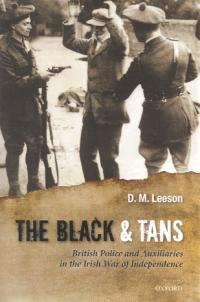The Black and Tans: British Police and Auxiliaries in the Irish War of The Black and Tans: British Police and Auxiliaries in the Irish War of Independence
Published in 20th-century / Contemporary History, Issue 1(Jan/Feb 2012), Reviews, Revolutionary Period 1912-23, Volume 20, World War I
The Black and Tans: British Police and Auxiliaries in the Irish War of The Black and Tans: British Police and Auxiliaries in the Irish War of Independence
D.M. Leeson
(Oxford University Press, £30)
ISBN 9780190598991
This book promises to give the inside story of the Black and Tans and the Auxiliary Division of the RIC, based on the official records. Unfortunately, over-reliance on those records provides a stilted and incomplete portrait of ‘the most notorious police force in the history of the British Isles’, instead of a historical roller-coaster. The records are illuminating, particularly on the social composition of these men. The Black and Tans were temporary constables recruited to fill gaps in the RIC. The majority were unskilled or semi-skilled workers (52%), with skilled manual workers (35%) comprising most of the remainder, so they were generally drawn from what would have been regarded as socially inferior groups to IRA members. High rates of pay, £3 10s a week, plus allowances worth at least another 16s were very attractive, especially at a time when unemployment was rising—from 2.4% in 1920 to 14.8% in 1921. Interestingly, few Tans described themselves as ex-soldiers, although the vast majority had served in the First World War. The Auxiliaries were different. These ex-officers had esprit de corps and provided a paramilitary strike-force, carrying the fight to the enemy and doing things soldiers could not, or would not, do. Most had been commissioned from the ranks as ‘temporary gentlemen’ in the latter stages of the First World War. Sixty per cent had served in the infantry, 37% in other combat arms and only 3% in the Service Corps. Leeson provides new perspectives on both groups. He also argues that there was a general breakdown of discipline within the RIC before the Tans and Auxiliaries arrived—and even that it was in large part Irish members of the force who led the newcomers astray. Leeson seems to believe that Irishmen still in the RIC by 1920 had already burnt their boats with the local population. But the evidence does not always warrant his conclusions. Consider, for instance:
None of these reports, including one in the Irish Times, the voice of Southern Unionism, doubted that it was a force of Auxiliaries from Gormanston who burnt Balbriggan. Some locals even expressed appreciation of the (albeit ineffectual) efforts of local RIC Constable Magill to restrain the Auxiliaries. Leeson cites the decision to burn down the pub of local Sinn Féin councillor John Derham as evidence that the reprisal was targeted selectively at rebels. Unfortunately the Auxiliaries burnt down three other pubs, the hosiery factory and many homes as well. A curious exception was Mrs Mary Smith’s licensed general store, where the fatal shooting of Head Constable Burke that sparked the ‘sack’ of the town had occurred. Burke was not a local policeman. He was passing through on his way to Gormanston very thirsty and unwilling to proceed further without a drink. Mrs Smith refused to serve him, his brother, who was an RIC sergeant, or their companions, who were Auxiliaries. The local RIC tried unsuccessfully to persuade the group to leave. The republican police were then summoned and in the ensuing fracas both Burke brothers were shot. Their companions fled in a waiting taxi. If Balbriggan RIC had been involved in this unofficial reprisal they would surely have included Mrs Smith’s premises as the most ‘legitimate’ target of all.The author does at least show what awful conditions the Tans and Auxiliaries lived in and why the IRA’s ability to pick and choose ambush sites left them at a severe physical and psychological disadvantage in combat. Casualty rates were high. Only 34% emerged from IRA attacks unscathed, with 42% wounded and 24% killed. In Cork the ratio of fatal to wounded casualties was 1:1. Surprisingly, Leeson does not examine the Auxiliary record in Cork and Dublin, using Galway as a case-study of a more typical county. This will leave many readers feeling cheated. Hopefully the author will make amends if there is a paperback edition. Meanwhile, my advice to would-be readers is to wait for the remainders. HI
Padraig Yeates is project manager of the 1913 Committee and author of A city in wartime: Dublin 1914–1918 (Gill and Macmillan).
















